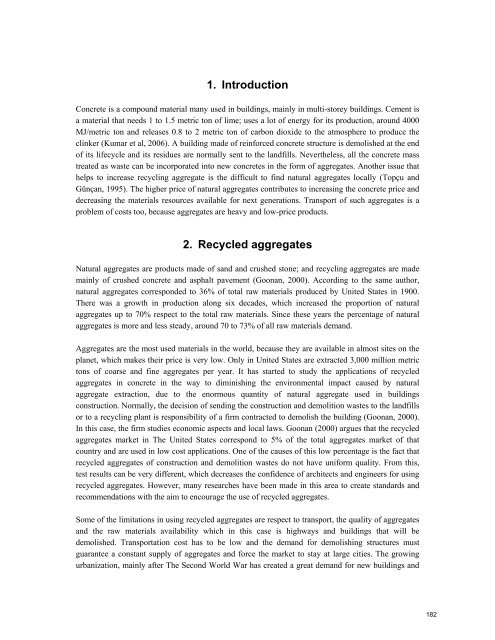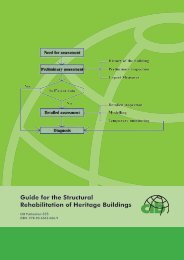CIB W116âSmart and Sustainable Built Environments - Test Input
CIB W116âSmart and Sustainable Built Environments - Test Input
CIB W116âSmart and Sustainable Built Environments - Test Input
You also want an ePaper? Increase the reach of your titles
YUMPU automatically turns print PDFs into web optimized ePapers that Google loves.
1. Introduction<br />
Concrete is a compound material many used in buildings, mainly in multi-storey buildings. Cement is<br />
a material that needs 1 to 1.5 metric ton of lime; uses a lot of energy for its production, around 4000<br />
MJ/metric ton <strong>and</strong> releases 0.8 to 2 metric ton of carbon dioxide to the atmosphere to produce the<br />
clinker (Kumar et al, 2006). A building made of reinforced concrete structure is demolished at the end<br />
of its lifecycle <strong>and</strong> its residues are normally sent to the l<strong>and</strong>fills. Nevertheless, all the concrete mass<br />
treated as waste can be incorporated into new concretes in the form of aggregates. Another issue that<br />
helps to increase recycling aggregate is the difficult to find natural aggregates locally (Topçu <strong>and</strong><br />
Günçan, 1995). The higher price of natural aggregates contributes to increasing the concrete price <strong>and</strong><br />
decreasing the materials resources available for next generations. Transport of such aggregates is a<br />
problem of costs too, because aggregates are heavy <strong>and</strong> low-price products.<br />
2. Recycled aggregates<br />
Natural aggregates are products made of s<strong>and</strong> <strong>and</strong> crushed stone; <strong>and</strong> recycling aggregates are made<br />
mainly of crushed concrete <strong>and</strong> asphalt pavement (Goonan, 2000). According to the same author,<br />
natural aggregates corresponded to 36% of total raw materials produced by United States in 1900.<br />
There was a growth in production along six decades, which increased the proportion of natural<br />
aggregates up to 70% respect to the total raw materials. Since these years the percentage of natural<br />
aggregates is more <strong>and</strong> less steady, around 70 to 73% of all raw materials dem<strong>and</strong>.<br />
Aggregates are the most used materials in the world, because they are available in almost sites on the<br />
planet, which makes their price is very low. Only in United States are extracted 3,000 million metric<br />
tons of coarse <strong>and</strong> fine aggregates per year. It has started to study the applications of recycled<br />
aggregates in concrete in the way to diminishing the environmental impact caused by natural<br />
aggregate extraction, due to the enormous quantity of natural aggregate used in buildings<br />
construction. Normally, the decision of sending the construction <strong>and</strong> demolition wastes to the l<strong>and</strong>fills<br />
or to a recycling plant is responsibility of a firm contracted to demolish the building (Goonan, 2000).<br />
In this case, the firm studies economic aspects <strong>and</strong> local laws. Goonan (2000) argues that the recycled<br />
aggregates market in The United States correspond to 5% of the total aggregates market of that<br />
country <strong>and</strong> are used in low cost applications. One of the causes of this low percentage is the fact that<br />
recycled aggregates of construction <strong>and</strong> demolition wastes do not have uniform quality. From this,<br />
test results can be very different, which decreases the confidence of architects <strong>and</strong> engineers for using<br />
recycled aggregates. However, many researches have been made in this area to create st<strong>and</strong>ards <strong>and</strong><br />
recommendations with the aim to encourage the use of recycled aggregates.<br />
Some of the limitations in using recycled aggregates are respect to transport, the quality of aggregates<br />
<strong>and</strong> the raw materials availability which in this case is highways <strong>and</strong> buildings that will be<br />
demolished. Transportation cost has to be low <strong>and</strong> the dem<strong>and</strong> for demolishing structures must<br />
guarantee a constant supply of aggregates <strong>and</strong> force the market to stay at large cities. The growing<br />
urbanization, mainly after The Second World War has created a great dem<strong>and</strong> for new buildings <strong>and</strong><br />
182

















